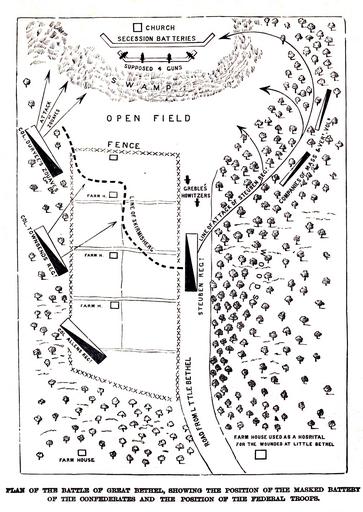MAKE A MEME
View Large Image

| View Original: | Plan_of_the_Battle_of_Great_Bethel.jpg (1457x2056) | |||
| Download: | Original | Medium | Small | Thumb |
| Courtesy of: | www.flickr.com | More Like This | ||
| Keywords: cartoon sketch drawing text illustration photo border Showing the Position of the Masked Battery of the Confederates and the position of the Federal Troops. (from Frank Leslie's Illustrated History of the Civil War..., edited by Louis Shepheard Moat, Published by Mrs. Frank Leslie,New York, 1895) The Battle of Big Bethel was one of the earliest land battles of the American Civil War. It took place on the Virginia Peninsula, near Newport News, on June 10, 1861. The Virginia State government had refused President Abraham Lincoln’s appeal for troops to put down the rebellion of the southern states, and its decision to secede from the Union was ratified by popular vote on May 23, 1861. Confederate Colonel (later Major General) John B. Magruder was sent down the peninsula to deter any advance on the state capital Richmond by Union troops based at the well-defended post of Fort Monroe. This garrison was commanded by Major General Benjamin Butler, a former Massachusetts lawyer and politician, who established a new camp at nearby Hampton and another at Newport News. Magruder had also established two camps, within range of the Union lines, at Big Bethel and Little Bethel, as a lure to draw his opponent into a premature action. Butler took the bait, when he and an aide, Major Theodore Winthrop, devised a plan for a dawn attack on June 10, 1861, after a night march to drive the Confederates back from their bases. Butler chose not to lead the force in person, for which he was later criticized. The plan proved too complex for his poorly-trained subordinates to carry out, especially at night, and his staff had also omitted to communicate the passwords. They were trying to advance without knowledge of the layout or strength of the Confederate positions, when a friendly fire incident gave away their own. The commander in the field, Massachusetts militia general Ebenezer Peirce, received the most criticism for the failed operation. The Union forces suffered 76 casualties, with 18 killed, including Major Winthrop and Lieutenant John T. Greble, the first regular army officer killed in the war. The Confederates suffered only 8 casualties, with 1 killed. Although Magruder subsequently withdrew to Yorktown and his defensive line along the Warwick River, he had won a propaganda victory and local Union forces attempted no further significant advance until the Peninsula Campaign of 1862. While small in comparison to many later battles, Big Bethel attracted considerable press coverage and exaggerated importance because of the newness of the war and the general feeling the war would be short. The engagement was also known as the Battle of Bethel Church or Great Bethel. Read more at en.wikipedia.org/wiki/Battle_of_Big_Bethel Showing the Position of the Masked Battery of the Confederates and the position of the Federal Troops. (from Frank Leslie's Illustrated History of the Civil War..., edited by Louis Shepheard Moat, Published by Mrs. Frank Leslie,New York, 1895) The Battle of Big Bethel was one of the earliest land battles of the American Civil War. It took place on the Virginia Peninsula, near Newport News, on June 10, 1861. The Virginia State government had refused President Abraham Lincoln’s appeal for troops to put down the rebellion of the southern states, and its decision to secede from the Union was ratified by popular vote on May 23, 1861. Confederate Colonel (later Major General) John B. Magruder was sent down the peninsula to deter any advance on the state capital Richmond by Union troops based at the well-defended post of Fort Monroe. This garrison was commanded by Major General Benjamin Butler, a former Massachusetts lawyer and politician, who established a new camp at nearby Hampton and another at Newport News. Magruder had also established two camps, within range of the Union lines, at Big Bethel and Little Bethel, as a lure to draw his opponent into a premature action. Butler took the bait, when he and an aide, Major Theodore Winthrop, devised a plan for a dawn attack on June 10, 1861, after a night march to drive the Confederates back from their bases. Butler chose not to lead the force in person, for which he was later criticized. The plan proved too complex for his poorly-trained subordinates to carry out, especially at night, and his staff had also omitted to communicate the passwords. They were trying to advance without knowledge of the layout or strength of the Confederate positions, when a friendly fire incident gave away their own. The commander in the field, Massachusetts militia general Ebenezer Peirce, received the most criticism for the failed operation. The Union forces suffered 76 casualties, with 18 killed, including Major Winthrop and Lieutenant John T. Greble, the first regular army officer killed in the war. The Confederates suffered only 8 casualties, with 1 killed. Although Magruder subsequently withdrew to Yorktown and his defensive line along the Warwick River, he had won a propaganda victory and local Union forces attempted no further significant advance until the Peninsula Campaign of 1862. While small in comparison to many later battles, Big Bethel attracted considerable press coverage and exaggerated importance because of the newness of the war and the general feeling the war would be short. The engagement was also known as the Battle of Bethel Church or Great Bethel. Read more at en.wikipedia.org/wiki/Battle_of_Big_Bethel | ||||